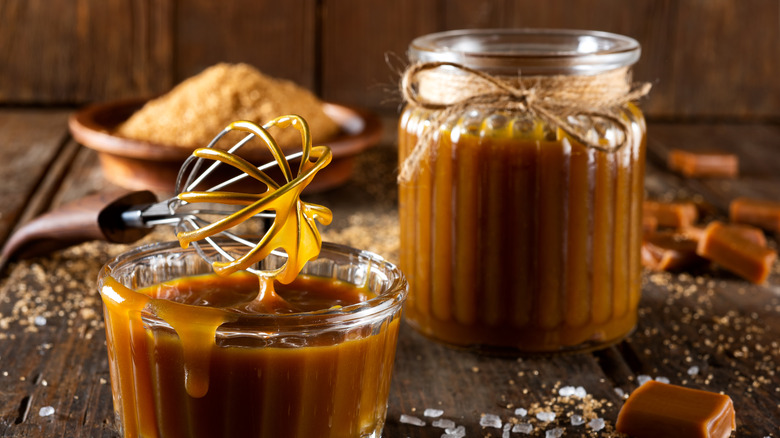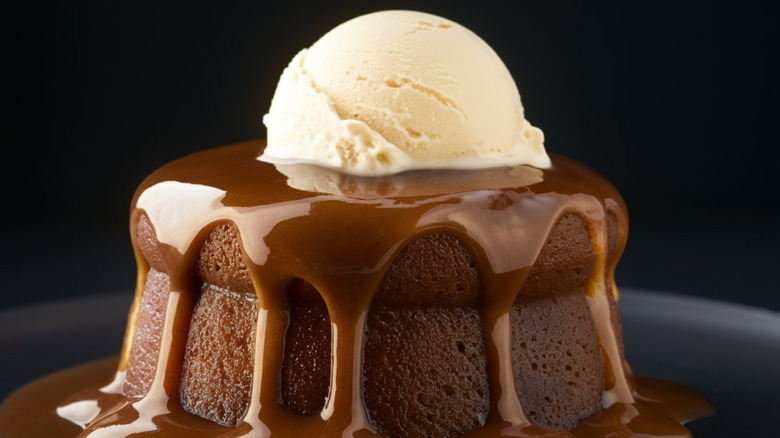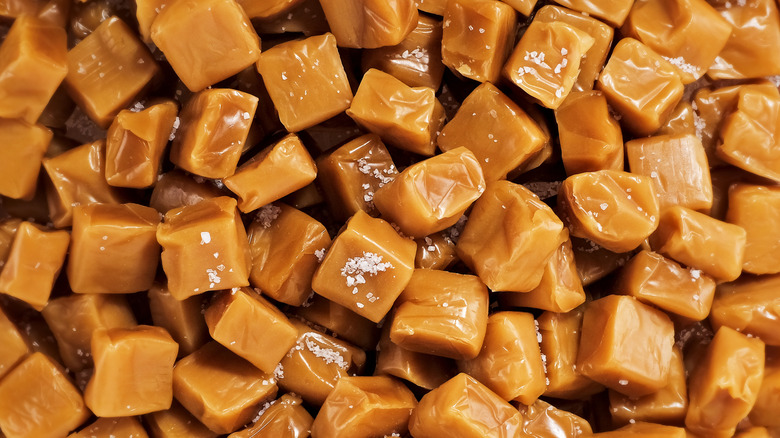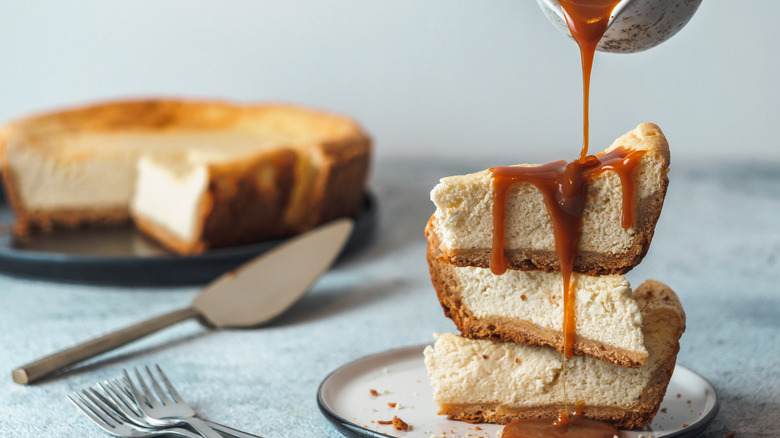What Separates Toffee From Caramel?
A sweet, gooey, rich, and buttery sauce glistens as it slides down the side of a vanilla ice cream scoop. It must be caramel. Or could it be toffee sauce? While the difference doesn't matter so much while you're eating it, there are subtle differences between caramel and toffee. These two sweet confections share similar colors and ingredients, but how they're made varies.
Something that defines toffee over caramel is its use of brown sugar — traditional caramel almost always uses white sugar. There are different methods and mixes of ingredients for making each, but the standard recipe for toffee includes only brown sugar (or sometimes molasses) and butter. On the other hand, caramel can just be made from sugar, but it is also made from a blend of sugar, cream, and water depending on the desired consistency. A simple at-home hack for making caramel is simmering down sweetened condensed milk.
Toffee is cooked at a lower temperature for longer. There's also toffee sauce, which uses the same ingredients but is not cooked as long, and sometimes cream is added to give it a smoother texture. Caramel has more of a range of texture and hardness; overall it is softer and more pliable than toffee because it is cooked for a shorter amount of time but to a higher temperature, plus it has the addition of cream and water. The longer cooking time gives toffee a richer, nuttier flavor, while caramel tends to be lighter and creamier.
How toffee is used
When we think of toffee, the crunchy, brittle candy coated in chocolate and chopped nuts might come to mind. This treat is also called English toffee, but the addition of nuts and chocolate is more common in America; in England, the nuts are left out. Remember that toffee uses brown sugar, but in America, it is sometimes made with white sugar or corn syrup, and would be considered buttercrunch. In England, the type of sugar used defines toffee, while in the United States, the hard, brittle texture defines it.
These chunks of toffee brittle are delicious enough on their own, but they can also be incorporated into other desserts to provide a "toffee crunch". Ben & Jerry's has an ice cream flavor called Coffee Toffee Bar Crunch which blends in chunks of chocolate-covered toffee bar. Another British treat is called black treacle toffee (also called bonfire toffee), which uses thick, dark sugarcane molasses (treacle), brown sugar, and butter to create a black, super-sweet toffee brittle. And we can't forget about the Heath Bar, an American candy bar that is simply a thin layer of toffee coated in milk chocolate.
Sticky toffee pudding, a classic British dessert features toffee sauce, rather than the hard bits of brittle. The base is a light sponge cake doused in toffee sauce, and then topped with vanilla ice cream or custard. Toffee sauce, typically darker and thicker than caramel, can also be drizzled on top of cakes and loaves.
How caramel is used
Caramel tends to be more common than toffee, at least in the United States. Sauce is its most common form, found in your Starbucks caramel latte, drizzled over ice cream and brownies, stuffed inside cookies, incorporated into pie and cheesecake — you name it. Caramel itself is a flavor of cakes and ice creams, sitting among the ranks of chocolate and vanilla. There's an endless list of iconic desserts that make use of the sticky sauce, including turtle brownies, caramel apples, apple pie a la mode, and flan.
When cooked down further, caramel also becomes thicker and more solid, but it is still more pliable than toffee. The chewy, tan, taffy-like blocks we eat as candy. are called "caramels." These are never crunchy like toffee, but have a dense, stick-to-the-roof-of-your-mouth texture. There are also hard caramel candies, which are not meant to be chewed, but sucked on. The closest caramel gets to toffee brittle is when it is used to make peanut brittle, where the caramel plays the role of binding the nuts together in a hard crunchy sheet.
One relatively unknown role caramel plays is in coloring certain foods and drinks. It's actually the most widely used food and beverage coloring, appearing in gravy, cola sodas, baked goods, soups, sauces, bread, and candy to increase the roasted, toasty brown color.
Can caramel and toffee be used interchangeably?
There is certainly an overlap between the two confections, and sometimes the difference between toffee and caramel may depend on the region and who you're asking. For the most part, caramel and toffee can be used interchangeably when in sauce form. Purists, bakers, and confectioners may say otherwise, but for the average home chef or baker, you're probably not going to ruin a dish by using one instead of the other. Just remember that toffee has a richer, buttery flavor, while caramel is lighter and creamy. As a sauce, they can both be added to lattes, drizzled on top of cheesecakes and brownies, or used to top ice cream. And yes, you can definitely add salt to each to create a salted caramel or salted toffee. However, when making recipes like caramel apples or sticky toffee pudding, it's best to use the original to ensure you're nailing the correct texture and taste.
When in a more solid form, it's not as logical to swap hard toffee brittle for softer caramel chunks, or vice versa. These two textures act differently when used in baking or added to something cold, like ice cream. Toffee brittle is great for a crunchy chocolate bar or a surprising crunch in cookies and ice cream. Caramel, in its more solid taffy-like form, becomes a bit too difficult to chew in ice cream, but chunks of it can be added to the center of a cookie.



